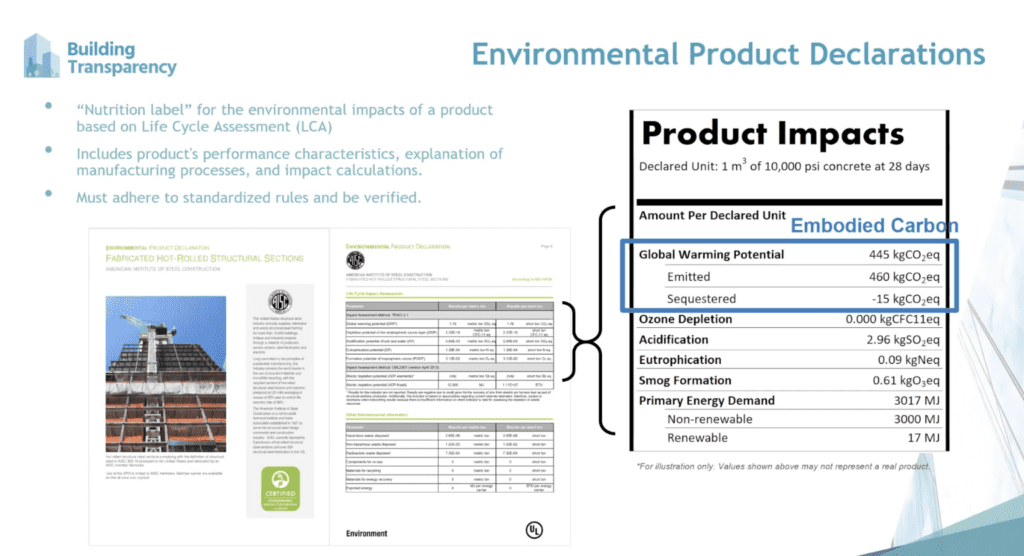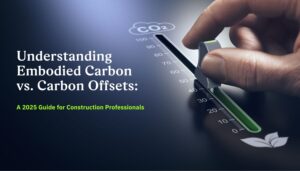
Lauren Breckenridge, LEED AP
Sustainability Associate at Green Badger
The EC3 Calculator is a resource for construction project teams to start diving into the embodied carbon of materials. Let’s take a look at how this is done and why it’s important for sustainability.

Back to Basics: Why is our carbon footprint important?
It’s no surprise that our everyday behaviors have an impact on climate change and greenhouse gas emissions. But something we have the power to change working in the construction industry is selecting materials that reduce a building’s carbon footprint. Studies are showing that the construction industry is responsible for a large portion of generated greenhouse gas emissions. As we continue to build new buildings the growing need for looking at and understanding the entire life-cycle of materials. The EC3 tool is a great starting point.
Let’s talk about Embodied Carbon
In the construction industry there is the ever growing importance of understanding how we can reduce carbon emissions of the building. This is where embodied carbon comes into place. Embodied Carbon is the CO2 emissions associated with materials and construction processes throughout the whole lifecycle of a building or infrastructure (Hussman, 2021). The embodied carbon is calculated by taking the emissions released during the raw material extraction, transportation, manufacturing, construction, maintenance, and the end-of-life of the materials.
What is the EC3 Calculator?
Architecture 2023 estimates that in roughly 40% of global emissions in 2028 were due to the building sector. 11% of those emissions were associated with materials and construction.

Life Cycle Stages
Taking a more complete look at the lifecycle stages included under embodied carbon, we’re talking about the EC3 tool specifically. So far the tool has been focused on the production of materials from different manufacturers. This is because the production impacts are often the biggest piece of the pie in terms of embodied carbon. In some cases, very significantly based on the manufacturing practices. This means we’re tracking A1-A3 embodied carbon:
- A1 – Raw materials supply
- A2 – Product transport
- A3 – Manufacturing

When looking at the lifecycle of a building, the production stages can be almost 70% of the total lifecycle impact of embodied carbon footprint. Even in the building use stage at 20%, that’s usually due to the replacement of interior products.
Materials
Additionally, with millions of products to specify in your project it is important to take into account the embodied carbon of those products. With the EC3 tool, they take the PDF files for any available EPD data and make it easily searchable in their database. Then, EC3 will let you link material quantity information on your projects.

How to incorporate it in your decision making process?
This is where your team has the opportunity to specify products that have a low carbon footprint. The EC3 Calculator give architects the opportunity to compare materials based upon their sustainability attributes. The tool gives you the ability to see what products the market has available, and compare like products to find the best option for your project. For example, the EC3 tool gives you the ability to compare concrete products against one another to find the one with the lowest embodied carbon.
Where to learn more about the Ec3 tool
Green Badger hosted a webinar on an Introduction to the EC3 Calculator and Embodied Carbon that you can watch on-demand. In the webinar we sit down with Vaclav Hasik, Data Manager at Building Transparency, Rowan Parris, Sustainability Program Manager at Turner Construction, and Jesce Walz, Architect at Perkins&Will, to discuss how to use the tool and best practices.

About Building Transparency and the EC3 calculator
“Building Transparency’s core mission is to provide the open access data and tools necessary to enable broad and swift action across the building industry in addressing embodied carbon’s role in climate change. Our premier service is the Embodied Carbon in Construction Calculator (EC3), a free database of construction EPDs and matching building impact calculator for use in design and material procurement.”
Learn more about Building Transparency.
References:
Hussman, R. (2021, March 29). What is embodied carbon? CarbonCure Technologies Inc. Retrieved November 17, 2022, from
Waldman, B., Huang, M., & Simonen, K. (2020). Embodied carbon in construction materials: a framework for quantifying data quality in EPDs. Buildings and Cities, 1(1), 625–636. DOI: https://doi.org/10.5334/bc.31





